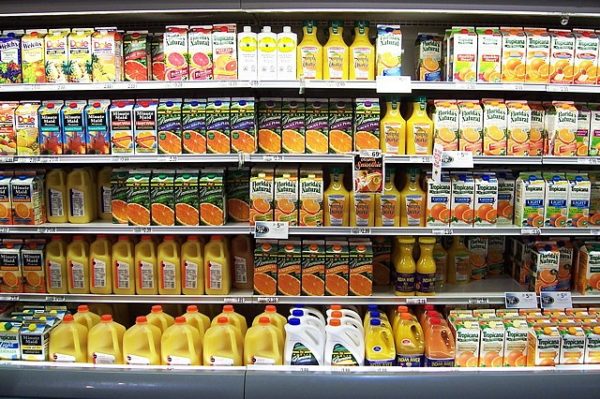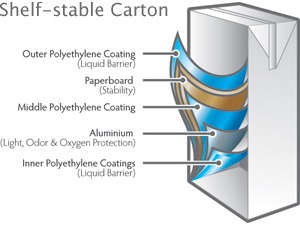Can Cardboard Egg Cartons Be Used As Shredded Material In Container Gardening
The process of recycling our paper and plastic materials is familiar to most of us. But what about their hybrid counterpart, the carton? Many mixed plastic and paper cartons do not get recycled, contributing to 78 million tons of packaging waste in U.S. landfills as of 2015.
Despite the fact that 92 percent of consumers surveyed by the Carton Council of North America said they expect their food packaging to be recycled, many municipal recycling programs do not accept plastic/paper hybrid cartons, including juice containers and ice cream cartons. Nevertheless, the United States is making a lot of progress in this recycling category. Sixty-one percent of people surveyed in 2017 said they recycle their food and beverage cartons, compared to 50 percent in 2015.
Here's some information to help demystify carton recycling.
What Makes Up a Milk/Juice Carton?
A type of packaging for food and beverage products, cartons are easy to recognize and are available in two types — shelf-stable (or aseptic) and refrigerated (gable-top).
- Shelf-stable cartons, as the name suggests, can be placed on store shelves and are used mostly for juice, milk, soy milk, soup, broth, and wine stored at room temperature.
- Refrigerated cartons are found in refrigerated sections of grocery stores and contain products like milk, juice, cream, and egg substitutes.
Cartons require fewer natural resources to transport due to their efficient product-to-packaging ratio. On average, a product sold in a shelf stable carton is 94 percent product and 6 percent packaging. This means that fuel consumption and greenhouse gas emissions are reduced since products in cartons can be shipped using fewer trucks.

Paper, plastic, and aluminum are layered together to make cartons: A typical shelf-stable carton averages 74 percent paper, 22 percent plastic, and 4 percent aluminum. A familiar form of this packaging is unrefrigerated soup or wine cartons.
Refrigerated cartons skip the aluminum and usually contain an 80 percent paper and 20 percent plastic combination to hold in the liquid. The Carton Council of Canada provides extensive information about the composition of different types of cartons and their recyclability.
Note:There are other products that we commonly refer to as "cartons" — ice cream cartons and take-out cartons. But from a recycling standing point, these are not the same as shelf-stable and refrigerated carton types and are not included in the recyclable carton category.
Top Responsible Carton Manufacturers
Your role in recycling improvements starts in the store aisle. Take the time to look at the maker of a carton before buying. Search for companies that have joined the Carton Council recycling initiative: Tetra Pak, Elopak, SIG Combibloc, and Evergreen Packaging.
Why Should I Recycle Cartons?
Recycling your cartons is a great way to keep unnecessary waste out of landfills, but your green contribution can start when you are shopping. Look for cartons that contain recycled materials. You will conserve energy by choosing a sustainable product package in the first place.
The high quality of the materials used in cartons makes them very desirable for remanufacturing into new products. All three materials used to make cartons can be reused. The challenge is separating those components during the recycling process. You can help by rinsing out the carton before putting it in your curbside program, if it is accepted (check whether your local hauler accepts paper/plastic cartons using your ZIP code)
Carton manufacturers are committed to increasing access to carton recycling in the United States, avoiding disposal in landfills and ensuring that the materials used to make cartons are reused, once the product they contained is gone. Recycling benefits manufacturers by reducing the cost of new paper and plastic purchases to make the next carton they ship to consumers.
Common Misconceptions About Cartons
Cartons are not recyclable: False
Cartons are recyclable. Made from mostly paper, cartons are in high demand to be made into new products. Manufacturers of cartons have joined forces in the Carton Council to increase access to carton recycling across the United States. To date, the availability of carton recycling has increased from 37 percent of households in 2011 to 62percent in 2018.
How did this happen? The Carton Council worked with key players in the recycling industry, from the recycling facilities to paper mills, to ensure that cartons are handled properly at recycling facilities. There are more than 2,000 carton recycling programs nationwide. If you don't currently have it, carton recycling may be coming to your program soon!
I can't recycle cartons because they don't have a symbol on them: False
To qualify for the recycle symbol, recycling of that product must be available to the majority of households in the U.S. This process is regulated by the Federal Trade Commission. While cartons are making progress towards placing the recycle symbol on packages, many cartons do not feature the symbol yet.
Check to see if you can recycle cartons locally by visiting the Carton Council or Earth911 Recycling Search.
Cartons are wax coated: False
Cartons do not contain any wax and have not for many years.
Modern cartons are made mainly from paper. Gable-top (or refrigerated) cartons contain additional layers of plastic, while aseptic (or shelf-stable) cartons contain additional layers of plastic and aluminum.
Cartons are designed to keep the product inside as fresh as possible, blocking out light and air that may cause products to spoil.
A cool fact about cartons: The colorful labeling on the outside is printed on the thin plastic layer. When recycled, removing that layer leaves behind valuable paper fibers that are used to make new paper products.

How Does Carton Recycling Work?
What happens to that carton after it's picked up from your recycling bin? Typically, its journey begins at a materials recovery facility where it gets separated from other waste and types of recyclables.
From there, the cartons are shipped to paper mills where they are mixed with water in a giant blender called a hydra-pulper. This process separates the paper from the plastic and aluminum. Once separation is complete, the paper fiber is ready to be transformed into new products such as tissues, office paper, and even building materials depending on the area of the country and the mill.
The plastic and aluminum materials are collected from the hydra-pulping process as well. The plastic, when re-purposed separately, is often used for shipping crates and building materials. However, in North America, it is often left in a combined state with the aluminum, creating a material called a poly/al mix. The poly/al mix has a limited secondary use market, but some mills have been able to use it to generate energy for their facilities.
What Do I Need to Know About Recycling Cartons?
- Always check with your local recycling or waste disposal service for recycling guidelines in your community. Curbside pickup is gaining popularity but is still not available everywhere.
- Be sure to remove any lids, straws, or fancy extras that come with your packaging. They go in the garbage.
- Recycle only empty cartons. Rinsing isn't required for recycling them, but it does help ensure that the container is empty, as well as help reduce potential odor or pest issues in the recyclables.
- It is not necessary to flatten your cartons and, in fact, it can slow the recycling process.
- When in doubt, keep it out. This rule of thumb is important with all recycling practices. Rather than risk contaminating your local recycling stream, keep materials that you aren't sure about out of your recycling.
Find a local recycling solution for cartons
Editor's note: Earth911 partners with many industries, manufacturers and organizations to support its Recycling Directory, the largest in the nation, which is provided to consumers at no cost. The Carton Council is one of these partners.
Originally published on November 20, 2015, this article was updated in November 2018.
Can Cardboard Egg Cartons Be Used As Shredded Material In Container Gardening
Source: https://earth911.com/home-garden/recycling-mystery-milk-and-juice-cartons/
Posted by: bryantderstly.blogspot.com

0 Response to "Can Cardboard Egg Cartons Be Used As Shredded Material In Container Gardening"
Post a Comment